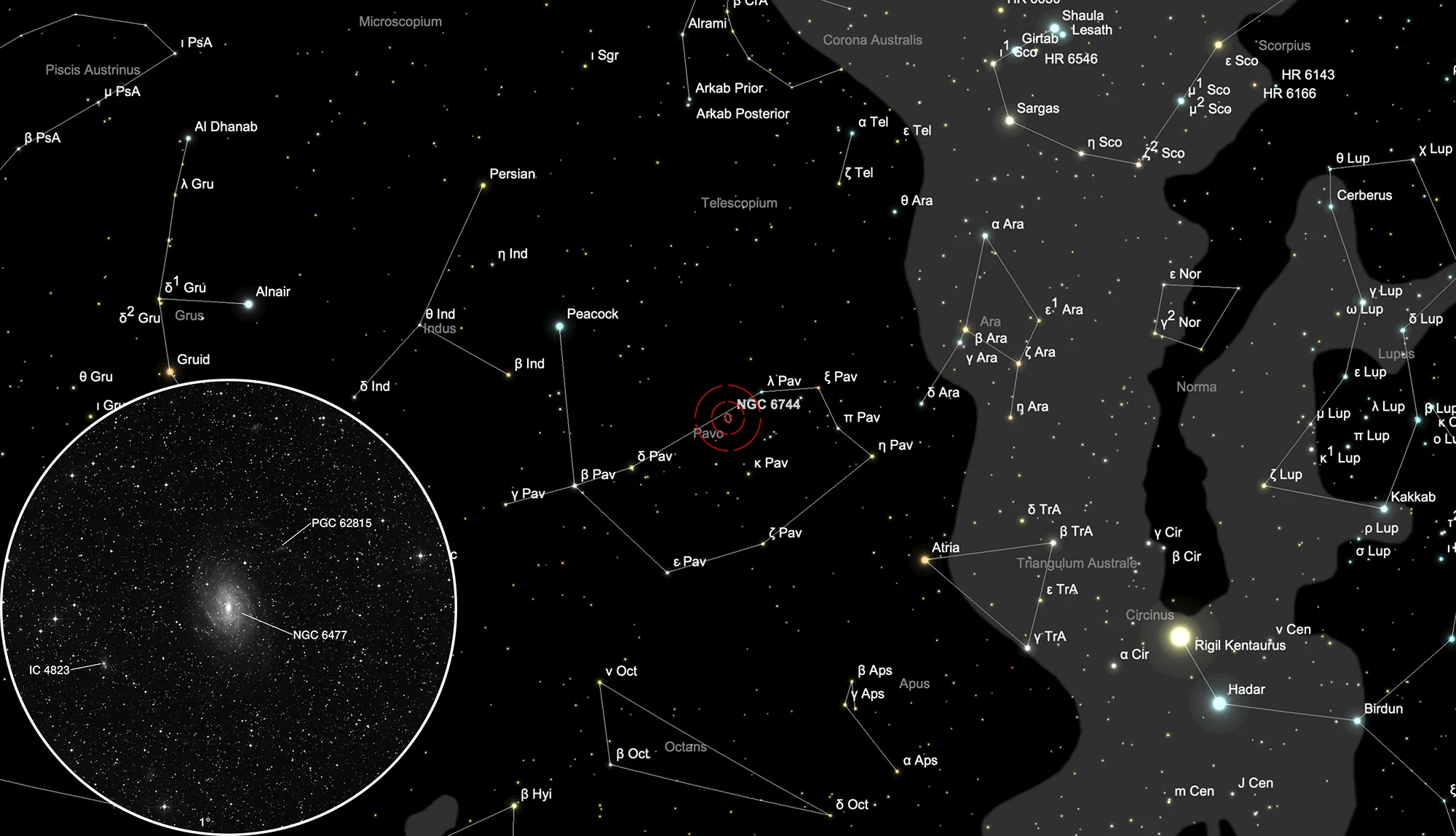Galaxy NGC 6744

History
This galaxy was discovered on 30 June 1826 by Scottish astronomer James Dunlop with his 9-inch reflector at Parramatta Observatory, 20 km west of Sydney. He observed it three times, listed it as number 262 (Δ 262) and described it as follows: «A pretty large very faint nebula, about 5' or 6' diameter, slightly bright towards the centre; a minute star is north of the nebula, and two stars of the 7th mag preceding.» [50]
On 20 June 1835, John Herschel observed this galaxy from South Africa and recorded it as h 3776: «Pretty bright; round; at first very gradually, then suddenly very much brighter in the middle; total diam 2', but that of the bright part = 15".» [11]
NGC 6744 was first photographed and resolved as a spiral on a photograph taken at Harvard's Arequipa Station between 1898 and 1901. DeLisle Stewart called it «!! spiral, complex in structure, diam. 10'.» [364]
IC 4823 was discovered on 13 August 1901 by DeLisle Stewart on a plate taken at Harvard's Arequipa station. He reported: «Very faint, very small» [364]
Physical Properties
NGC 6744 is a spiral galaxy of morphological type SAB(r)bc, similar to our own Milky Way and is the nearest and brightest galaxy of that type on the southern hemisphere. It belongs to the Pavo group and is located at a distance of about 8.5 Mpc. NGC 6744 has a nucleus with LINER (Low Ionization Nuclear Emission Line Region) surrounded by three line emitting regions. The nucleus is associated with a blue compact source, probably corresponding to the active galactic nucleus (AGN). One of these regions, located ∼1" southeast of the nucleus, seems to be associated with the ionization cone of the AGN. The other two regions are located ∼1" south and ∼0 6 northeast of the nucleus and are not aligned with the gaseous rotating disk. Spectral synthesis showed evidence that this galaxy may have gone through a merger about one billion years ago. [38]
IC 4823 are in fact two interacting galaxies, consisting of PGC/LEDA 62891 and PGC/LEDA 62894. With a redshift of z ≈ 0.037 those galaxies are much further away than NGC 6744 which has a redshift of z ≈ 0.0028. [145]
| Name | RA | Dec | Type | bMag | vMag | B-V | SB | Dim | PA | z | D(z) | MD | Dreyer Description | Identification, Remarks |
|---|---|---|---|---|---|---|---|---|---|---|---|---|---|---|
| NGC 6744 | 19 09 46.1 | -63 51 24 | Gx (SBbc) | 9.1 | 8.5 | 0.6 | 14.4 | 20.1 × 12.9 | 15 | 0.002805 | 11.85 | 9.500 | cB, cL, R, vg, svmbM, r | h 3776; GC 4464; ESO 104-42; AM 1905-635; IRAS 19050-6354 |
| NGC 6744 A | 19 08 43.7 | -63 43 48 | Gx (IBm) | 15.1 | 14.5 | 0.6 | 14.6 | 1.8 × 0.7 | 110 | cB, cL, R, vg, svmbM, r | h 3776; GC 4464; ESO 104-38 | |||
| IC 4823 1 | 19 12 16.0 | -63 58 33 | Gx (S) | 14.3 | 13.5 | 0.8 | 13.5 | 1.1 × 0.8 | 20 | 0.037000 | 156.2 | vF, vS | ESO 104-45; AM 1907-640 | |
| IC 4823 2 | 19 12 14.0 | -63 59 01 | Gx (S) | 15.5 | 14.7 | 0.8 | 12.8 | 0.5 × 0.4 | 0.037000 | 156.2 | vF, vS | ESO 104-45A; AM 1907-640 |
Finder Chart
The galaxy NGC 6744 is located in the southern celestial hemisphere in the constellation Pavo at declination -63°. Hence it is not visible from Europe. On 9 July it in opposition with the Sun and is therefore highest in the sky at around midnight.
